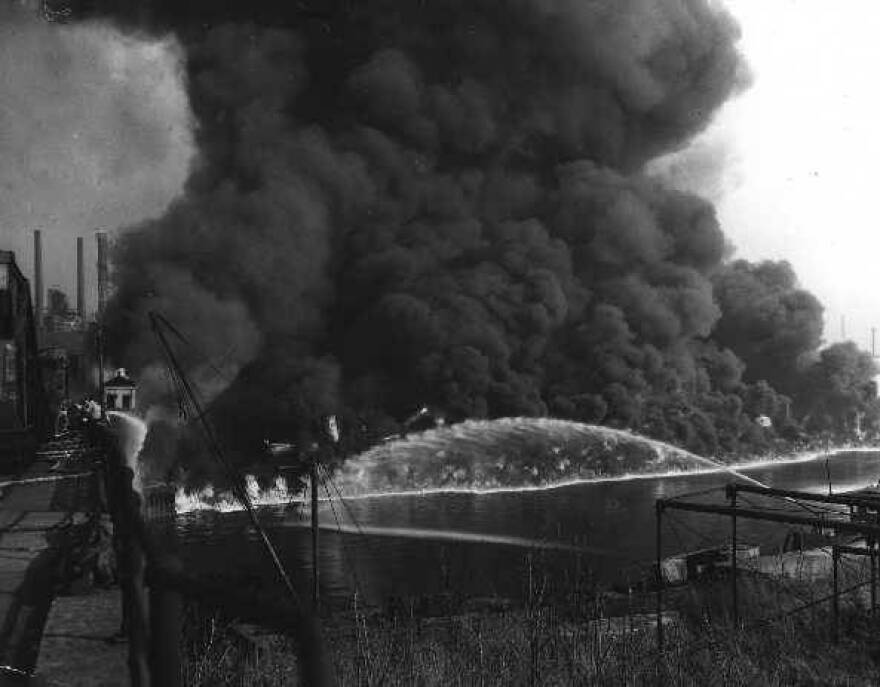On June 22, 1969, a train passing over a trestle in Cleveland created a spark that caused a fire on the Cuyahoga River. That spark brought nationwide attention to the river 50 years ago, and it’s tainted Cleveland’s reputation for decades. Since then, fact and fiction have often mixed in the popular history of the fire.
Cleveland Metroparks historical interpreter Doug Kusak and Case Western Reserve University law professor Jonathan Adler provide some context to the myths surrounding the river’s story.
Myth #1: Rivers Can Burn
No they can’t. Rivers don’t burn, because liquid’s don’t burn.
“We did not have a burning river, we had a fire on our river,” explained Kusak.
Myth #2: Time Magazine Published a Photo of the 1969 Fire
A photo of the 1952 fire [Cleveland Press Collection at Cleveland State University Library]
In August 1969, a Time magazine story reported on cities with polluted rivers. The accompanying photo captured a fire on the Cuyahoga River from 1952. The story was buried in the magazine’s environment section, but its cover story on Edward Kennedy and the Chappaquiddick incident was even bigger news than the moon landing. That story helped elevate the myth of the burning river.
Adler says no one has seen a real picture of the 1969 fire.
“As best we can tell, no one arrived on June 22, 1969, to actually catch a picture of the fire,” said Adler. “The picture that ran in the local papers is a picture of the clean-up operation.”
Plain Dealer coverage of the 1969 Cuyahoga River fire [Plain Dealer archive]
Myth #3: The 1969 Fire Was the Only One on the Cuyahoga River
Kusak says by most estimates, there were 13 fires on the Cuyahoga.
“By the standards of river fires, the 1969 fire was nothing,” said Adler. “There had been some real infernos that had burned docks, that burned facilities, that killed people.”
A 1912 fire killed five and ruined several boats. In 1922, according to Adler, there was another fire in the same spot. And in 1952, a huge weekend fire caused thousands of dollars worth of damage.
Back then, pollution was seen as the cost of having successful industry.
Myth #4: The Cuyahoga River Was the Only "Burning River"
The Cuyahoga wasn’t the only river burning 50 years ago.
“I’ve found accounts of fires in Columbus, in Detroit, in Philadelphia, in Baltimore Harbor,” said Adler.
Myth #5: The Fire Was a Sign of Things Getting Worse
Adler says things in Cleveland were actually getting better. Voters had approved a $100 million bond issue to clean up the river in 1968, a year before the famous fire.
And the ’69 fire wasn’t the only reason Congress created the Environmental Protection Agency in 1970 and passed the Clean Water Act in 1972.
“There were a handful of events — the '69 fire, the Santa Barbara oil spill and so on,” said Adler. “That really captured the nation's attention and crystallized the sense that something was very wrong environmentally.”
The EPA itself says the conversation around protecting the environment started in the 1960s. To Kusak, the spotlight on Cleveland pushed the federal government to act.
“It was kind of like that wake-up call to the country, we’ve got to change things,” said Kusak.
The Fire's Reputation 50 years later
People still get parts of the Cuyahoga River’s story wrong. Adler sees it mostly with folks outside of Cleveland, like the TV channel that used a photo of a burning river in Russia to represent Cleveland during the Indians’ post-season in 2016.
TBS used a pic of a burning river to show CLE during Indians coverage. Should they apologize? #RallyTogether https://t.co/FuMEfnk1O3 pic.twitter.com/niQApglvTh
— Cleveland 19 News (@cleveland19news) October 11, 2016
“It’s like a cultural meme that won’t go away,” said Adler. “I’ve certainly tried and spent a lot of the last 10, 15 years trying to educate people about the more complete history.”
Kusak wants to see more focus on how far the river has come since that last fire in 1969. He calls the river the region’s defining resource, but says people must continue to protect it.
“Cleveland has the Cuyahoga River,” said Kusak. “That’s why Cleveland’s here, that’s why the suburbs are here. So if we don’t take care of that, we’re not taking care of ourselves.”
Note: A previous version of this story stated Kusak believed there were 12 fires on the Cuyahoga. He says most estimates indicate there were 13. The audio version of this story has been corrected.



![The Cuyahoga River, near the site of the 1969 fire. Now property of Arcelor-Mittal. [Elizabeth Miller/ideastream]](https://npr.brightspotcdn.com/dims4/default/53e9171/2147483647/strip/true/crop/3000x2250+0+0/resize/880x660!/quality/90/?url=http%3A%2F%2Fnpr-brightspot.s3.amazonaws.com%2Flegacy%2Fuploads%2F2019%2F1%2F21%2FIMG_2674.JPG)




